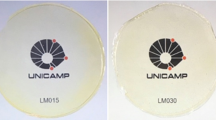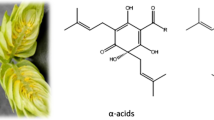Abstract
Chitosan films (CF) [1 and 2% w/v] alone and with cinnamaldehyde (CNE) [0.25, 0.5 and 1% v/v] were prepared using an emulsion method, and the obtained films were characterized in terms of water vapor permeability (WVP), water solubility and optical, mechanical and antioxidant properties. The incorporation of CNE at 1% (v/v) significantly decreased the water solubility of the film by approximately 4% for the 1 and 2% CF films, whereas the WVP increased (2.5–3.5 times). The incorporation of CNE (0.25 and 0.5%) into 2% CF significantly increased the tensile strength (TS) (62 and 34%, respectively) and the percent elongation (%E) values, 26, 30 and 52% for CF that contained 0.25, 0.5 and 1% CNE, respectively. The largest value of the elasticity modulus (EM) was observed for 2% CF with 0.25% CNE. All films exhibited a yellow appearance (b*), but the CNE content had a marked impact on the coloration of the films. The CNE recoveries of the CF films (1 and 2%) with 1% of CNE were high (43 and 67%). The antioxidant activities indicated that the incorporation of 1% CNE into CF films (1 and 2%) increased the antioxidant activity. The protective effects of the films with and without CNE on erythrocytes were very strong (36–72% hemolysis inhibition). These results suggest there are potential applications for CF-CNE films as active packaging for the preservation of food products.




Similar content being viewed by others
References
Nostro A, Scaffaro R, D’Arrigo M, Botta L, Filocamo A, Marino A, Bisignano G (2012) Study on carvacrol and cinnamaldehyde polymeric films: mechanical properties, release kinetics and antibacterial and antibiofilm activities. Appl Microbiol Biot 96:1029–1038
Friedman M, Kozukue N, Harden LA (2000) Cinnamaldehyde content in foods determined by gas chromatography-mass spectrometry. J Agric Food Chem 48:5702–5709
Carlotti M, Sapino S, Cavalli R, Trotta M, Trotta F, Martina K (2007) Inclusion of cinnamaldehyde in modified γ-cyclodextrins. J Incl Phenom Macrocycl Chem 57:445–450.
Campos CA, Gerschenson LN, Flores SK (2001) Development of edible films and coatings with antimicrobial activity. Food Bioprocess Technol 4:849–875.
Friedman M, Juneja VK (2010) Review of antimicrobial and antioxidative activities of chitosans in food. J Food Protect 73:1737–1761
Lin D, Zhao Y (2007) Innovations in the development and application of edible coatings for fresh and minimally processed fruits and vegetables. CRFSFS 6:60–75.
Vargas M, Albors A, Chiralt A, González-Martínez C (2006) Quality of cold-stored strawberries as affected by chitosan–oleic acid edible coatings. Postharvest Biol Technol 41:164–171.
Rojas-Graü MA, Soliva-Fortuny R, Martín-Belloso O (2009) Edible coatings to incorporate active ingredients to fresh-cut fruits: a review. Trends Food Sci Technol 20:438–447.
Azevedo EP, Kumar V (2012) Rheological, water uptake and controlled release properties of a novel self-gelling aldehyde functionalized chitosan. Carbohyd Polym 90:894–900.
Jagadish R, Divyashree K, Viswanath P, Srinivas P, Raj B (2012) Preparation of N-vanillyl chitosan and 4-hydroxybenzyl chitosan and their physico-mechanical, optical, barrier, and antimicrobial properties. Carbohyd Polym 87:110–116.
Hongpattarakere T, Riyaphan O (2008) Effect of deacetylation conditions on antimicrobial activity of chitosans prepared from carapace of black tiger shrimp (Penaeus monodon). Songkhlanakarin J Sci Technol 30:1–9.
López-Mata MA, Ruiz-Cruz S, Ornelas-Paz JJ, Cira-Chávez LA, Silva-Beltrán NP (2015) Antibacterial and antioxidant properties of edible chitosan coatings incorporated with essential oils. Int J Pharm Bio Sci 6(4):251–264
Casariego A, Souza BWS, Cerqueira MA, Teixeira JA, Cruz L, Díaz R, Vicente AA (2009) Chitosan/clay films’ properties as affected by biopolymer and clay micro/nanoparticles’ concentrations. Food Hydrocolloid 23:1895–1902
Guillard V, Broyart B, Bonazzi C, Guilbert S, Gontard N (2003) Preventing moisture transfer in a composite food using edible films: experimental and mathematical study. J Food Sci 68:2267–2277
ASTM (1995) Standard test methods for tensile properties of thin plastic sheeting.
Han JH, Floros JD (1997) Casting antimicrobial packaging films and measuring their physical properties and antimicrobial activity. J Plast Film Sheet 13:287–298.
Pereda M, Ponce A, Marcovich N, Ruseckaite R, Martucci J (2011) Chitosan-gelatin composites and bi-layer films with potential antimicrobial activity. Food Hydrocolloid 25:1372–1381
Du WX, Olsen C, Avena-Bustillos R, McHugh T, Levin C, Friedman M (2008). Antibacterial activity against E. coli O157: H7, physical properties, and storage stability of Novel carvacrol-containing edible tomato films. J Food Sci 73:M378–M383
Carlotti ME, Sapino S, Cavalli R, Trotta M, Trotta F, Martina K (2007) Inclusion of cinnamaldehyde in modified γ-cyclodextrin. J Incl Phenom Macrocycl Chem 57:445–450
Moein S, Moein M (2010) Relationship between antioxidant properties and phenolics in Zhumeria majdae. J Med Plants Res 4:517–521
Re R, Pellegrini N, Proteggente A, Pannala A, Yang M, Rice-Evans C (1999) Antioxidant activity applying an improved ABTS radical cation decolorization assay. Free Radical Bio Med 26:1231–1237
Lu J, Jin Y, Liu G, Zhu N, Gui M, Yu A Li X (2010) Flavonoids from the leaves of Actinidia kolomikta. Chem Nat Compd 46:205–208
Rotta J, Ozório RA, Kehrwald AM, de Oliveira-Barra GM, de Melo-Castanho-Amboni RD, Barreto PLM (2009) Parameters of color, transparency, water solubility, wettability and surface free energy of chitosan/hydroxypropylmethylcellulose (HPMC) films plasticized with sorbitol. Mater Sci Eng 29:619–623.
Rubilar JF, Cruz RMS, Silva HD, Vicente, AA, Khmelinskii I, Vieira MC (2013) Physico-mechanical properties of chitosan films with carvacrol and grape seed extract. J Food Eng 115:466–474
Abdollahi M, Rezaei M, Farzi G (2012) A novel active bionanocomposite film incorporating rosemary essential oil and nanoclay into chitosan. J Food Eng 111:343–350
Acevedo-Fani A, Salvia-Trujillo L, Rojas-Graü MA, Martín-Belloso O (2015) Edible films from essential-oil-loaded nanoemulsions: Physicochemical characterization and antimicrobial properties. Food Hydrocoll 47:168–177.
Berger J, Reist M, Mayer J, Felt O, Gurny R (2004) Structure and interactions in chitosan hydrogels formed by complexation or aggregation for biomedical applications. Eur J Pharm Biopharm 57:35–52
Chen H, Hu X, Chen E, Wu S, McClements DJ, Liu S, Li B, Li Y (2016) Preparation, characterization, and properties of chitosan films with cinnamaldehyde nanoemulsions. Food Hydrocoll 61:662–671.
Rodríguez-Núñez JR, Madera-Santana TJ, Sánchez-Machado DI, López-Cervantes J., Valdez HS (2014) Chitosan/hydrophilic plasticizer-based films: preparation, physicochemical and antimicrobial properties. J Polym Environ 22:41–51.
Schauer CL, Chen MS, Chatterley M, Eisemann K, Welsh ER, Price RR, Schoen PE, Ligler FS (2003) Color changes in chitosan and poly (allyl amine) films upon metal binding. Thin Solid Films 434:250–257
Soliman EA, Khalil AA, Deraz SF, El-Fawal G, Elrahman SA (2012) Synthesis, characterization and antibacterial activity of biodegradable films prepared from Schiff bases of zein. J Food Sci Technol 51(10): 2425–2434. doi:10.1007/s13197-012-0792-y.
Marin L, Stoica I, Mares M, Dinu V, Simionescu BC, Barboiu M (2013) Antifungal vanillin-imino-chitosan biodynameric films. J Mater Chem B 1(27):3353–3358.
Fernandez-Saiz P, Lagaron J, Ocio M (2009) Optimization of the film-forming and storage conditions of chitosan as an antimicrobial agent. J Agric Food Chem 57(8):3298–3307. doi:10.1021/jf8037709
Seydim A, Sarikus G (2006) Antimicrobial activity of whey protein based edible films incorporated with oregano, rosemary and garlic essential oils. Food Res Int 39:639–644
Rivero S, García M, Pinotti A (2009) Composite and bi-layer films based on gelatin and chitosan. J Food Eng 90:531–539
Sánchez-Moreno C (2002) Review: methods used to evaluate the free radical scavenging activity in foods and biological systems. Food Sci Technol Int 8:121–137.
Yen TB, Chang ST (2008) Synergistic effects of cinnamaldehyde in combination with eugenol against wood decay fungi. Bioresource Technol 99:232–236
Torres E, Marín V, Aburto J, Beltrán HI, Shirai K, Villanueva S, Sandoval G (2012) Enzymatic modification of chitosan with quercetin and its application as antioxidant edible films. Appl Biochem Micro 48:151–158
Park S, Marsh K, Rhim J (2002) Characteristics of different molecular weight chitosan films affected by the type of organic solvents. J Food Sci 67:194–197
Xie W, Xu P, Liu Q (2001) Antioxidant activity of water-soluble chitosan derivatives. Bioorg Med Chem Lett 11:1699–1701
Youn SK, Kim YJ, Ahn DH (2001) Antioxidative effects of chitosan in meat sausage. J Korean Soc Food Sci Nutr 30:477–481.
Kyung WK, Thomas RL (2007) Antioxidative activity of chitosan with varying molecular weights. Food Chem 101:308–313
Hirano S, Zhang M, Nakagawa M, Miyata T (2000) Wet spun chitosan–collagen fibers, their chemical N-modifications, and blood compatibility. Biomaterials 21:997–1003
Otoni CG, de Moura MR, Aouada FA, Camilloto GP, Cruz RS, Lorevice MV, Soares FF, Mattoso LH (2014) Antimicrobial and physical-mechanical properties of pectin/papaya puree/cinnamaldehyde nanoemulsion edible composite films. Food Hydrocoll 41:188–194.
Acknowledgements
Financial support from ITSON (PROFAPI 00500) is gratefully acknowledged.
Author information
Authors and Affiliations
Corresponding author
Rights and permissions
About this article
Cite this article
López-Mata, M.A., Ruiz-Cruz, S., de Jesús Ornelas-Paz, J. et al. Mechanical, Barrier and Antioxidant Properties of Chitosan Films Incorporating Cinnamaldehyde. J Polym Environ 26, 452–461 (2018). https://doi.org/10.1007/s10924-017-0961-1
Published:
Issue Date:
DOI: https://doi.org/10.1007/s10924-017-0961-1




